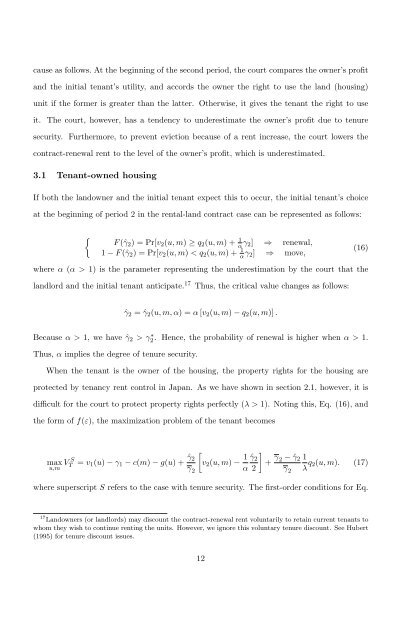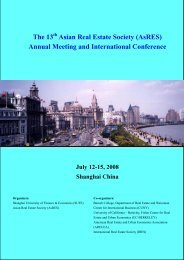You also want an ePaper? Increase the reach of your titles
YUMPU automatically turns print PDFs into web optimized ePapers that Google loves.
cause as follows. At the beginning of the second period, the court compares the owner’s profit<br />
and the initial tenant’s utility, and accords the owner the right to use the land (housing)<br />
unit if the former is greater than the latter. Otherwise, it gives the tenant the right to use<br />
it. The court, however, has a tendency to underestimate the owner’s profit due to tenure<br />
security. Furthermore, to prevent eviction because of a rent increase, the court lowers the<br />
contract-renewal rent to the level of the owner’s profit, which is underestimated.<br />
3.1 Tenant-owned housing<br />
If both the landowner and the initial tenant expect this to occur, the initial tenant’s choice<br />
at the beginning of period 2 in the rental-land contract case can be represented as follows:<br />
�<br />
F (ˆγ2) = Pr[v2(u, m) ≥ q2(u, m) + 1<br />
α γ2] ⇒ renewal,<br />
1 − F (ˆγ2) = Pr[v2(u, m) < q2(u, m) + 1<br />
α γ2] ⇒ move,<br />
where α (α > 1) is the parameter representing the underestimation by the court that the<br />
landlord and the initial tenant anticipate. 17 Thus, the critical value changes as follows:<br />
ˆγ2 = ˆγ2(u, m, α) = α [v2(u, m) − q2(u, m)] .<br />
Because α > 1, we have ˆγ2 > γ∗ 2 . Hence, the probability of renewal is higher when α > 1.<br />
Thus, α implies the degree of tenure security.<br />
When the tenant is the owner of the housing, the property rights for the housing are<br />
protected by tenancy rent control in Japan. As we have shown in section 2.1, however, it is<br />
difficult for the court to protect property rights perfectly (λ > 1). Noting this, Eq. (16), and<br />
the form of f(ε), the maximization problem of the tenant becomes<br />
max<br />
u,m V S T = v1(u) − γ1 − c(m) − g(u) + ˆγ2<br />
�<br />
v2(u, m) −<br />
γ2 1<br />
α<br />
(16)<br />
�<br />
ˆγ2<br />
+<br />
2<br />
γ2 − ˆγ2 1<br />
γ2 λ q2(u, m). (17)<br />
where superscript S refers to the case with tenure security. The first-order conditions for Eq.<br />
17 Landowners (or landlords) may discount the contract-renewal rent voluntarily to retain current tenants to<br />
whom they wish to continue renting the units. However, we ignore this voluntary tenure discount. See Hubert<br />
(1995) for tenure discount issues.<br />
12



